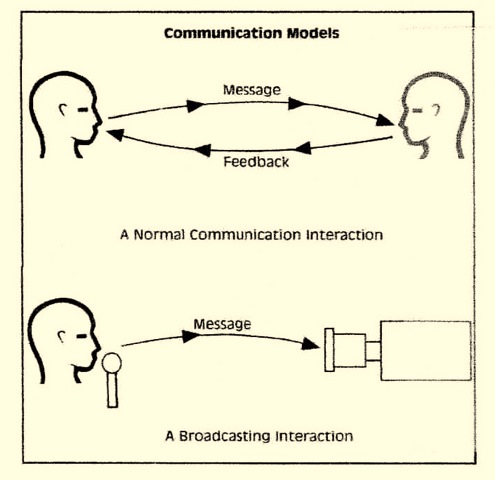|
Let’s Get Personal: Finding Your
Conversational Voice Over Delivery
 By Ann S. Utterback, Ph.D. By Ann S. Utterback, Ph.D. Voice Specialist Reading Pam Turlow’s recent article, The 'Conversational' Voice Over Read, I was struck by how much her dilemma echoes what I have heard as a voice specialist from news broadcasters for the last 25 years. The old days of television "news announcers” went out with TV consoles that had doors on the front and rabbit ears up top.
What everyone wants to hear now is what I call "comfortable communicators.”
You might call them the guy or girl next door. Whatever they’re called, newscasters need to sound like they’re talking to a friend and not a vast television audience.
TALKING TO YOURSELF
As a voice over artist, you probably already know how hard that is to achieve in a sound booth.
Think about it. Unless you had the worst childhood ever, you didn’t grow up locked in a closet talking to yourself every day.
But that’s exactly what you’re doing in your sound booth. What’s missing in there is crucial to sounding conversational. That’s feedback.
SUPER MODEL
Let me explain. Below is a standard communication model.
 What you have in the top drawing is a sender sending a message and a receiver hearing it. Then there’s the crucial link of the feedback.
The feedback, both verbal and nonverbal, from the receiver is actually what gives us all the cues that allow us to sound conversational.
Let’s look at an example: Imagine you’re at Starbuck’s telling a friend about your latest voice over gig.
Suddenly, your friend begins looking at his or her watch and looking toward the door. You’d get the nonverbal message to speed up your story because your friend needs to leave, wouldn’t you?
If he or she began yawning while you’re talking, you’d make your vocal delivery more animated and possibly louder.
DO IT AUTOMATICALLY
We do these things without even thinking about them. We use the feedback from the listener to determine how we use our voice to deliver our message.
Now go back to that model above and look at the lower drawing.
No feedback, right? This sender is talking to a microphone and a camera with no feedback in the equation.
INVENT THE FEEDBACK
But here’s the good news: If you were that sender you would know how to invent feedback from a listener.
You do it every time you’re on the phone. You imagine what your listener looks like and how they’re reacting to what you’re saying.
Imagine calling your best friend right now. You can see him or her clearly in your mind, can’t you?
Being able to see them in your mind is what allows you to sound conversational when you call them on the phone.
This same skill will help with Pam’s dilemma. And it just gets better.
TWEAK YOUR DELIVERY
Another good thing about imagining the receiver of your message is that you can adjust the receiver based on the type of delivery you want to use.
I’m sure you already do this when you strive to create the delivery your client wants.
But you may be thinking of it the way a lot of broadcasters do.
I ask new clients whom they imagine they’re talking to, and I get some pretty outrageous answers. Everything from "spirits sort of floating around in space” to "a room full of Army generals.”
KNOW THAT PERSON
What I’ve found when working with the concept of imagining feedback is that you have to be really concrete in your image of the single person you’re talking to.
The person you imagine has to be someone you know well and can imagine vividly in your mind.
There’s a difference between talking to a vaguely defined elderly nursing home patient and your 90-year-old Nanna who read you stories until you were eight.
My advice is to get as concrete as you can.
KNOW SCRIPT'S TARGET
And go a step further.
In television we talk a lot about target demographics (age, sex, income, education, etc.). I’m sure this applies to your work, as well.
When you think about what you’re selling in an ad spot, for example, zero in on the demographic for the product.
Then think of a real person in your life that fits that demographic. Talk to that person and imagine them reacting to every word you say.
See their feedback.
PHOTO CAN HELP
When you begin trying this, you can even tack a photo of the person to the wall of the sound booth and focus on it as you talk.
It also helps to consciously observe the feedback you get when talking to friends and family. Anything that helps you connect with your person is fair game.
So the next time you’re struggling with how to come up with that illusive conversational read, just get a friend to help you out!
ABOUT ANN ...
Ann S. Utterback, Ph.D., is a voice specialist with more than 40 years experience and has helped hundreds of people make the most of their voices, working with broadcasters, voice over artists and podcasters around the world. An author of eight books and over 50 articles on voice, her Broadcast Voice Handbook is used in newsrooms and classrooms throughout the U.S. It is designed as a self-help book that teaches how to improve every aspect of your voice. Her website offers more information, including a link to her informative blog and a free mp3 to begin your voice improvement.
|
|
|
On Michael Langsner's Voice-Over Roadmap Podcast
Get your bi-weekly dose here ... all things VO!
Inspiring interviews help your VO career
For essential voice-over business strategies
As of the NEW website launch, 03/22/2012






.gif)

.png)

Chris, I especially thank you for pointing out my oversight in the article. I, of course, do not mean to imply that voiceover artists don't need to have an arsenal of types of deliveries. The "announcer" voice is most definitely needed in some circumstances (although I'm not sure I agree with all you listed).
My article was coming from the frustration voiced in Pam's previous post about being asked to be conversational and struggling with how to do that. It does not apply to the countless other voices that a good VO artist uses whether it's announcing or sounding like a cartoon character. Hope that clears this up for you and other readers.
Randye
The simple fact is this: The MOST successful voiceover artists of all time have the "announcer" sound.
I can easily name several who are making 7 figures as "announcers." Most every promo voice I hear on the network radio stations, network TV stations, local news stations, etc., still employ an "announcer" sound. The announcer sound is everywhere. EVERYWHERE. It's in the supermarket announcing what's on sale, it's at the ball game asking you to stand for the national anthem, in the boxing ring before they get ready to rumble, on the airplane explaining how to put on the oxygen mask, at the casino, announcing the show, at the movie theatre before the movie starts, at the opera, the ballet, on your GPS, at church, at the museum, at the DMV with the automated announcements, at the airport, at dog shows, at the Grammy Awards, the Academy Awards, during the Game Show, before the Jay Leno show, before the Conan O'Brien Show, etc.
Even all the media attention about Ted Williams wasn't about his "conversational" delivery. If everyone truly wants the "comfortable communicator," why all the spotlight on Ted's golden announcing voice?
It was his great "announcer" voice that got him a contract to do Kraft commercials, not his conversational delivery. I seriously doubt a homeless man with a conversational delivery would have garnered so much attention and instant money and fame.
He was offered a job offer to "announce" the Cavaliers games, too. Guess they weren't seeking a conversational delivery.
There's also the imaginary 'wall' that sometimes prohibits direction from the client or questions / clarification sought by the voice artist, due to both parties wanting to please the other and 'get it right'.
This is a simple way to visualise who you're talking to, why you're talking to them and what action you're asking them to take, creating a more naturally persuasive read.
Thanks, Ann!